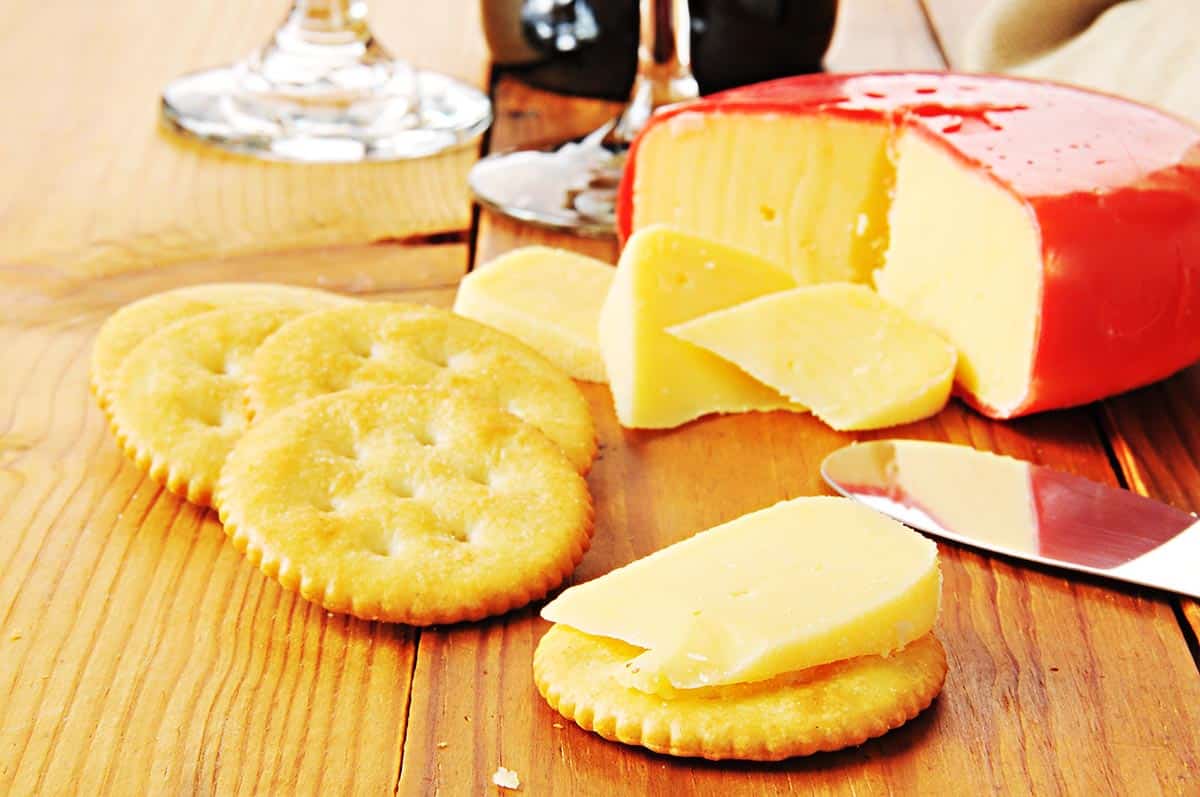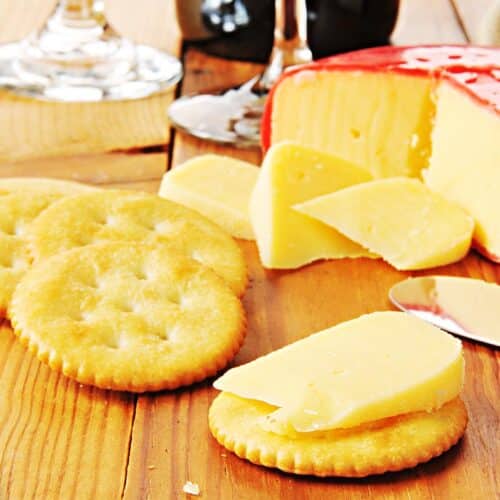Gouda is a favorite among cheese lovers everywhere. Its unique taste appeals to both home cooks and connoisseurs alike. But what does Gouda cheese taste like? And what makes it so good?
We’ve got tons of ways to use Gouda in recipes. If you’ve never tasted this cheese before, you’ll crave a slice after this article.

Gouda is a type of cheese from the Netherlands, with its origins dating back to medieval times. It gets its name from the city of Gouda, where people first traded it.
Traditional Gouda cheesemaking is also one of the oldest still in use today.
Gouda comes in three forms: flat wheels, wedges, and slices. Small slices are great for snacks and satisfying cravings. Wedges are perfect for parties. And if you want to take a shot at aging your own Gouda, wheels are best.
You’ll find commercial and artisanal Gouda in supermarkets, but the latter is rarer. You’ll have better luck finding artisanal Gouda online.
When cutting open a Gouda wheel, you’ll see three layers.
The first layer is a red wax coating which keeps the cheese moist.
Underneath this is the Gouda’s natural golden rind.
Lastly, there’s the cheese’s yellow interior or “paste.” Both the rind and paste color deepens as the Gouda ages.
An exception to this is smoked Gouda cheese. It doesn’t come with a wax coating and is smoke-cured while aging. This smoking results in the Gouda having a deeper brown rind as it ripens.
Gouda’s fascinating history starts with its namesake. In the Middle Ages, certain cities had market rights in selling a specific product. At that time, Gouda was the only place in Holland where people could sell cheese.
Today, cheese markets still exist in Gouda as tourist attractions. But the practice remains the same. When summer rolls in, so does the cheese. Sellers display an array of Dutch cheeses, including Gouda cheese, in the town square. Buyers join vertical tastings and use handclaps as bargaining signals.
For the Dutch, Gouda isn’t only cheese but a huge part of their culture. The recipe passes from generation to generation, ensuring a long line of cheesemongers. Some cheese farms even date back a hundred years!
Since Gouda isn’t a protected name, the cheese can come from anywhere worldwide, and it will be true Gouda. But connoisseurs beg to differ. Some say “authentic” Gouda should originate from farm cheese only made on Dutch soil.
The key ingredients in cheesemaking are raw milk, cheese culture, and rennet. Raw milk is favored over pasteurized milk because it’s rich in enzymes and adds flavor. Cheese culture helps break down the milk. And rennet speeds up the curdling process.
First, the milk and the cheese culture are heated up. Heating activates the culture, which turns lactose into lactic acid, raising acidity. Increased acidity kickstarts the coagulation process and gives the cheese flavor and aroma.
Adding rennet begins the curdling process, making the milk very thick. The enzyme separates the solid and liquid parts, turning them into curds and whey.
“Washing the curds” is a crucial step unique to making Gouda. Replacing the whey with water removes excess lactose. Less lactose means low acidity, resulting in sweeter cheese.
Stirring controls the curds’ moisture and texture. Prolonged stirring sucks out the water, making for a drier cheese. But a shorter stir produces a wetter and creamier consistency.
The next step involves pouring the curds molds or “hoops.” Weights press the curd into shape, giving Gouda its flattened wheel appearance.
Pressing each side for a couple of hours solidifies the cheese’s shape. The heavier the weight, the drier the Gouda becomes.
Soaking the cheese in a brine bath is important when making Gouda. The salty brine absorbs moisture, preserves the cheese, and develops the rind. In older-aged Gouda, the salt crystals add flavor and texture.
Aging is the final and longest process with the biggest impact on Gouda’s taste. After the cheese dries, it’s coated in wax and set at room temperature. The aging can last from four weeks to more than a year.
It has a distinctive flavor that can range from mild and creamy to sharp and tangy, depending on how long it has been aged.
Younger Gouda cheeses tend to have a mild buttery taste, a slightly sweet flavor, and a smooth, creamy texture. As the cheese ages, it becomes firmer and develops a more complex flavor with nutty and caramelized notes.
Aged Gouda cheese has a more pronounced taste. It has strong earthy and nutty flavors with a slight saltiness. Because of their caramel tones, people often liken aged Goudas to butterscotch.
Gouda is a versatile cheese that can be used in many different types of dishes, from sandwiches and salads to cheese plates and baked dishes.
Gouda cheese’s texture, like its taste, varies based on age.
Young Gouda cheese has high moisture, giving it a springy rind and a soft paste. It also has a creamy, melt-in-your-mouth consistency and feels like butter when cut.
By comparison, aged Gouda is drier, denser, and crumbles easily. Looking closer at matured Gouda cheese, you may notice it has tiny holes called “eyes.” These form during the aging process when air bubbles in the cheese burst.
People often find “white stuff” on aged Gouda’s rind. The “white stuff” is leftover salt crystals from the brine bath. And not only are they safe to eat, but they also add crunchiness.
Are there other Gouda cheeses out there? Yes! In fact, there are six common varieties.
The biggest difference between these varieties is the fat content.
Younger cheeses are richer in fat, giving them a better melt.
Older Gouda has less fat and is more crumbly, perfect for grating.
Here’s a quick look at these Gouda varieties:
If you’ve never tasted Gouda before, cheddar’s flavor comes close. Surprisingly, Gouda has lots of similarities with this English cheese. They’re even used to substitute each other in tons of recipes. That said, they do have their differences.
Here’s how these cheeses compare:
Both Gouda and cheddar follow a similar cheesemaking process. But with cheddar, the curds are “cheddared,” not “washed.” Cheddaring involves cutting the curds and stacking them to drain more whey. Both kinds of cheese are aged the same.
Cheddar and Gouda are similar in appearance, with pale yellow to deep orange colors. But the latter commonly comes wrapped in red wax. You’ll usually find Gouda sold as cheese wheels and cheddar sold as blocks.
Gouda and cheddar’s differences blur when talking about taste. Cheddar is very similar to aged Gouda due to its sharp and rustic flavors. And some say young Gouda is sweeter than cheddar, but only by a bit.
Cheddar’s texture is a mix of young and aged Gouda cheese. It has a smooth paste like young Gouda but a brittle texture like old Gouda. Unlike aged Gouda, cheddar lacks holes because the cheddaring removes moisture and air.
Old Gouda and cheddar don’t melt as well as young Gouda. Again, this is because cheddar had most of its moisture removed. But cheddar still melts, just at a higher temperature and at a thicker consistency when compared to young Gouda.
Most consider Gouda a gourmet cheese, and its availability frequently supports this. Unlike cheddar, Gouda isn’t as commercially available. It’s mostly sold online or at artisanal shops.
Gouda’s wide range of possible flavors makes it incredibly versatile. From fun snacks to fancy dinner recipes, here are some great Gouda cheese recipes in cooking:
Have a need for cheese and want a quick and easy snack? Gouda grilled cheese is the way to go. A slice of Gouda and a dab of cream cheese melted to perfection would fix your cravings. Pair it with a warm bowl of tomato soup to bring out the Gouda’s creaminess.
Suppose you plan to eat Gouda cheese with friends; what better way than Gouda fondue? The cheese’s high moisture content makes it a great choice for dipping. Other soft cheeses like Gruyere and Swiss cheese add to melted Gouda’s luscious taste. Tortilla chips, potatoes, and crusty bread make for tasty dippers.
Even simple and easy dishes like mac and cheese can have more complexity with Gouda. And to mix it up a bit, try using special varieties to have a more pronounced flavor. Smoked Gouda would be your cheese of choice. It strikes a good balance between a savory taste and a good melt. Save smoked Gouda mac n’ cheese on your comfort food list.
A good way to elevate a burger is to add Gouda. It melts quickly and brings a contrasting complementary flavor to the savory meat. Plus, the melted Gouda looks fantastic over a beefy patty. We can even take it further with smoked Gouda for extra aroma.
For shreds, Gouda pairs well with cheddar over pasta, sauces, soups, and stews. Gouda’s earthy and tangy flavors add a unique blend and depth to these dishes. And is especially true with older Gouda.
Gouda can also be eaten on its own as a snack, topped on crostinis or added to a charcuterie board. You can also pair it with salami – a cold-cut favorite for Gouda cheese. Or go cheese on cheese by pairing Gouda with other soft cheeses like Brie, feta, and ricotta.
Finally, Gouda is a brilliant cheese substitute. It’s a must-pick for those who want to change up soft cheeses recipes. Gouda can be a good stand-in for Edam, Monterey Jack, and Havarti.
Gouda cheese has a long shelf life, but sadly, it doesn’t last forever.
Once you open the wax seal, it should stay fresh for two to three weeks.
Keeping Gouda in the fridge adds another week. You can also follow the best-before date to double-check.
Why does Gouda spoil in the first place? Unlike cheese cellars, our pantries and fridges are unregulated for aging cheese. Gouda cheese is prone to temperature changes. Too hot, and you’ll get moldy cheese. Too cold, and you’ll change Gouda’s texture.
Gouda is originally from the Netherlands. But most commercial Gouda is now made globally. In the United States, most cheese production comes from Wisconsin.
Like all cheeses, Gouda should breathe. Wrap in parchment and keep in a dry pantry. Storing Gouda cheese in the fridge is ideal, but keep it in the warmest drawer. Exterior moisture increases the risk of mold.
Edam is the closest to Gouda cheese’s flavor. Both Dutch cheeses follow the same cheesemaking process. But unlike Gouda, Edam cheese’s flavor is lighter and sharper. It’s also drier compared to Gouda’s creamy texture.
Gouda is a Dutch cheese that quickly melts in your mouth, leaving sweet undertones. It’s also known for its mild flavor and buttery smooth texture. Young Gouda cheese is high in moisture, perfect for a rich and gooey melt.
But what does Gouda cheese taste like when aged? Fully matured Gouda offers a stronger flavor with rustic tones and a slightly salty rind. While aged Gouda lacks moisture, it makes up for its bold taste.






